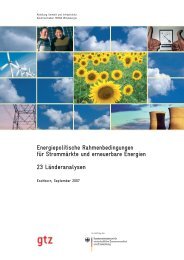K u rzfassu n g sb an d - Graz University of Technology
K u rzfassu n g sb an d - Graz University of Technology
K u rzfassu n g sb an d - Graz University of Technology
- Keine Tags gefunden...
Erfolgreiche ePaper selbst erstellen
Machen Sie aus Ihren PDF Publikationen ein blätterbares Flipbook mit unserer einzigartigen Google optimierten e-Paper Software.
118 Energieinnovation 2006<br />
5.1.4 „Effects <strong>of</strong> Germ<strong>an</strong> Wind Power Generation on North-West<br />
Europe<strong>an</strong> Network Congestion – A Numerical Analysis Using<br />
Nodal Pricing“<br />
Karen Freund*, Till Jeske, Ina Rumi<strong>an</strong>tseva*, H<strong>an</strong>nes Weigt* (Dresden<br />
<strong>University</strong> <strong>of</strong> <strong>Technology</strong>/Department <strong>of</strong> Business M<strong>an</strong>agement <strong>an</strong>d<br />
Economics) 1<br />
Wind power is the fastest growing energy generation sector in Germ<strong>an</strong>y, as risk <strong>an</strong>d pr<strong>of</strong>it are easily<br />
calculated due to fixed feed in tariffs according to Germ<strong>an</strong> energy sector legislation. In the past, wind<br />
power generation was decentralized <strong>an</strong>d thus impacts on the grid in terms <strong>of</strong> congestion problems<br />
played only a minor role. However, considering a further exp<strong>an</strong>sion <strong>of</strong> onshore <strong>an</strong>d, more import<strong>an</strong>tly,<br />
projected construction <strong>of</strong> considerable <strong>of</strong>fshore capacities, the question arises whether the existing<br />
grid is still capable <strong>of</strong> reliably securing energy supply.<br />
Germ<strong>an</strong> wind power capacities are mostly located in Northern parts <strong>of</strong> Germ<strong>an</strong>y while major dem<strong>an</strong>d<br />
centres are concentrated in the South. Due to power distribution through the entire Europe<strong>an</strong><br />
integrated network (UCTE grid) according to relative line imped<strong>an</strong>ces, Germ<strong>an</strong>y’s neighbours to the<br />
North West, namely Benelux countries, are affected by unintended but inevitable cross-border flows<br />
congesting their grids. With the intended exp<strong>an</strong>sion <strong>of</strong> <strong>of</strong>f shore wind capacities in the Germ<strong>an</strong> North<br />
Sea, this problem is bound to aggravate. Based on different scenarios <strong>of</strong> Germ<strong>an</strong> wind power<br />
exp<strong>an</strong>sion within the next decades, which were developed by DENA (Germ<strong>an</strong> Energy Agency), we<br />
assess the impact <strong>of</strong> the integration <strong>of</strong> additional wind power capacities on the existing grid, focusing<br />
on effects on Benelux countries.<br />
Scientific <strong>an</strong>alysis so far is scarce: DENA (2005) has made <strong>an</strong> assessment <strong>of</strong> the costs <strong>of</strong> wind power<br />
exp<strong>an</strong>sion to the year 2015, but only took into account the domestic situation. Leuthold et al. (2005)<br />
have studied the impact <strong>of</strong> a nodal pricing system on electricity flows from wind power within the<br />
Germ<strong>an</strong> grid. Our paper extends the latter <strong>an</strong>alysis beyond the Germ<strong>an</strong> borders: we carry out<br />
economic simulations <strong>of</strong> relev<strong>an</strong>t parts <strong>of</strong> the UCTE high voltage grid using GAMS s<strong>of</strong>tware. By<br />
providing grid topology data (including line tr<strong>an</strong>smission capacities <strong>an</strong>d line imped<strong>an</strong>ces) as well as<br />
dem<strong>an</strong>d <strong>an</strong>d supply data, power flows within the grid are determined. Power flow simulation is based<br />
on a simplified model <strong>of</strong> a fixed UCTE grid topology, which includes all lines <strong>an</strong>d nodes, but ignores<br />
topology variation through switching. Load flows are calculated within the DC load flow model<br />
(Schweppe, Caram<strong>an</strong>is, Tabors, Bohn, 1988, Stigler <strong>an</strong>d Todem, 2005), i.e. neglecting reactive power<br />
flows. Nodal reference dem<strong>an</strong>d is based on <strong>an</strong>nual power dem<strong>an</strong>d per country which is assigned to<br />
provinces relative to provincial GDP. Dem<strong>an</strong>d curves are defined by reference dem<strong>an</strong>d <strong>an</strong>d <strong>an</strong><br />
assumed dem<strong>an</strong>d elasticity <strong>of</strong> 0.25. Supply is constrained by generating capacities <strong>of</strong> power pl<strong>an</strong>ts<br />
which charge const<strong>an</strong>t marginal production costs for their energy output.<br />
We model a nodal pricing system as a welfare maximizing approach, assuming perfect markets<br />
without exercise <strong>of</strong> market power by players. The nodal pricing system allows for implicit pricing <strong>of</strong> line<br />
capacity sending price signals to consumers <strong>an</strong>d producers. In a first step, the feasibility <strong>of</strong> the former<br />
Germ<strong>an</strong> st<strong>an</strong>d alone model under nodal pricing is evaluated by extending the previously existing<br />
model beyond the Germ<strong>an</strong> borders, now including Denmark, Benelux, Fr<strong>an</strong>ce, Austria <strong>an</strong>d<br />
Switzerl<strong>an</strong>d. It is shown that prices in the st<strong>an</strong>d alone model are overestimated in South-Western<br />
Germ<strong>an</strong>y, most likely due to the neglect <strong>of</strong> exch<strong>an</strong>ge capacity with Fr<strong>an</strong>ce. In contrast, prices in Lower<br />
Saxony (North-Western Germ<strong>an</strong>y) are underestimated, because the st<strong>an</strong>d alone model does not take<br />
into account congestion occurring in the Netherl<strong>an</strong>ds that inhibit North-South power flows within<br />
Germ<strong>an</strong>y. In a second step, the extension <strong>of</strong> Germ<strong>an</strong> wind capacity (<strong>of</strong>f shore in the North <strong>an</strong>d Baltic<br />
Sea, on shore in the whole country) as well as a minor grid extension are modelled. As expected,<br />
prices in Northern Germ<strong>an</strong>y <strong>an</strong>d Denmark decrease due to cheap local wind power production.<br />
Results also show that in case <strong>of</strong> high wind power production even the exp<strong>an</strong>ded grid is overloaded<br />
1 Dresden <strong>University</strong> <strong>of</strong> <strong>Technology</strong>,Department <strong>of</strong> Business M<strong>an</strong>agement <strong>an</strong>d Economics,<br />
Chair <strong>of</strong> Energy Economics; D – 01069 Dresden, Germ<strong>an</strong>y;<br />
Tel: +49-(0)351-463-39764, Fax: +49-(0)351-463-39763;<br />
e-mail: karen.freund@mailbox.tu-dresden.de, Url: www.ee2.biz;





